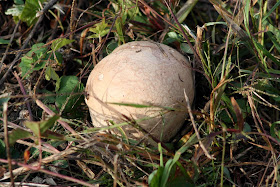By Beth Sullivan
After the last month of
rain and high humidity, we are all feeling a little damp and
mildewed. And mold indeed is thriving, along with all of its fungal
relatives. It is now prime mushroom season, a bit earlier this year
than usual, thanks to the conditions. In a typical year, peak
mushroom season, and all the festivals celebrating everything
mycological, happen in September.
 |
| Amanita mushrooms are characterized by the rough bumps on top. They are deadly to eat and should not be touched. |
 |
| Turkey tails are unique, often beautiful and will persist into winter. |
Fungi are in a Kingdom of their own
They
are not plants at all, and surely they are not animals, but you would
be surprised at some of their characteristics. They do not have true
roots, or a vascular system, or flowers and seeds. They contain no
chlorophyll so are unable to make their own food utilizing nutrients
and sunlight. Have you noticed there are no real green mushrooms?
They rely on obtaining their nutrients from the decay process that
they are part of on the forest floor, utilizing all the dead plant
material that is present there. They absorb their food through this
process, rather than eating it or making it. Some are very
specific, growing only near certain trees, by certain species of
other plants, in very narrow ranges of pH (soil acidity). After
several days, they themselves begin to get slimy and moldy and smell
terrible. There is a very definite smell of decay and over-ripeness
in the woods at this time of year. Here’s a fun fact: the outer
tough skin of many mushrooms is made of Chitin, which is the same
material as the shells of lobsters and crabs. Strange organisms.
Along with a wide
variation in color, they also take many forms: the familiar umbrella,
ruffles, shelves, turkey tails, and puffballs. If you have ever come
upon a solid white ball on your lawn and think golf ball, experiment
a little. A firm young puffball will be white all the way through and
have a pleasing earthy smell. But wait a few weeks and find a
puffball that has become browner with age. A touch with your toe or a
flick of the finger will make it puff, explode with fine black
dust, which is all the spores contained within. All mushrooms
reproduce by releasing dusty spores.
 |
| This chicken mushroom is hard to miss and prized by many. |
 |
| Early on a puffball is firm on the inside. Later it will dry and fine black spores will be released when disturbed. |
 |
| It's easy to see where a coral mushroom get its name. |
More than meets the eye
Mushrooms are actually
the visible, spore-producing bodies of a largely underground network
of rhizome threads that comprise a fungus. The spread of the
rhizomes extends great distances, but only one or two mushrooms may
emerge. In other cases, many will pop up in the same area. Many are
quite specific about where they grow and the conditions they need for
survival, but one thing is generally universal: they need moisture to
thrive. They can dry down to a dusty mass, but add water and some
will reconstitute as good as new. There are fungi in every ecosystem
- from the Antarctic, to deserts and jungles and cities, and even on
our very own skin.
Take a hike in any
shady cool woodland. Avalonia has many of these. Look on the ground,
in the leaves, look on rotting tree trunks, branches and stumps.
Notice the colors and textures and shapes. They may have the
appearance of being nibbled. They are frequently eaten by small
mammals, woodland turtles and insects and slugs. But don’t be
tempted to pick and sample. Fungi are of great value for medicinal
purposes, food processes (as in making cheese) and as prized edibles
themselves. But be warned: there are also many mushrooms that are
poisonous, or fatal, if eaten even in small quantities, so never mess
with mushrooms unless you are with an expert. Bring a camera or
sketch pad instead.
 |
| The underside of most mushrooms is covered with gills which hold and release spores. |
 |
| The underside of bolete mushrooms have a spongy appearance and will often bruise blue when touched. |
Photographs by Beth
Sullivan.

No comments:
Post a Comment